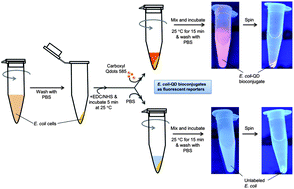E. coli–quantum dotbioconjugates as whole-cell fluorescent reporters for probing cellular damage†
Abstract
A

* Corresponding authors
a
Sabanci University Nanotechnology Research and Application Center, Orta Mah., Tuzla, Istanbul, Turkey
E-mail:
javed@sabanciuniv.edu, anjum@sabanciuniv.edu
Fax: +90 216 483 9885
Tel: +90 216 483 9879
A

 Please wait while we load your content...
Something went wrong. Try again?
Please wait while we load your content...
Something went wrong. Try again?
R. S. Chouhan, J. H. Niazi and A. Qureshi, J. Mater. Chem. B, 2013, 1, 2724 DOI: 10.1039/C3TB20338G
To request permission to reproduce material from this article, please go to the Copyright Clearance Center request page.
If you are an author contributing to an RSC publication, you do not need to request permission provided correct acknowledgement is given.
If you are the author of this article, you do not need to request permission to reproduce figures and diagrams provided correct acknowledgement is given. If you want to reproduce the whole article in a third-party publication (excluding your thesis/dissertation for which permission is not required) please go to the Copyright Clearance Center request page.
Read more about how to correctly acknowledge RSC content.
 Fetching data from CrossRef.
Fetching data from CrossRef.
This may take some time to load.
Loading related content
